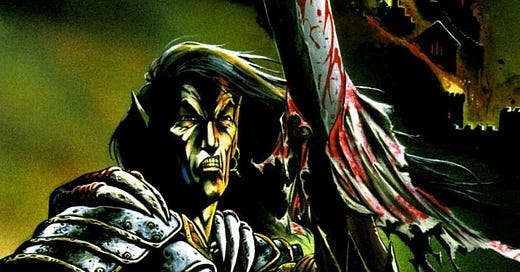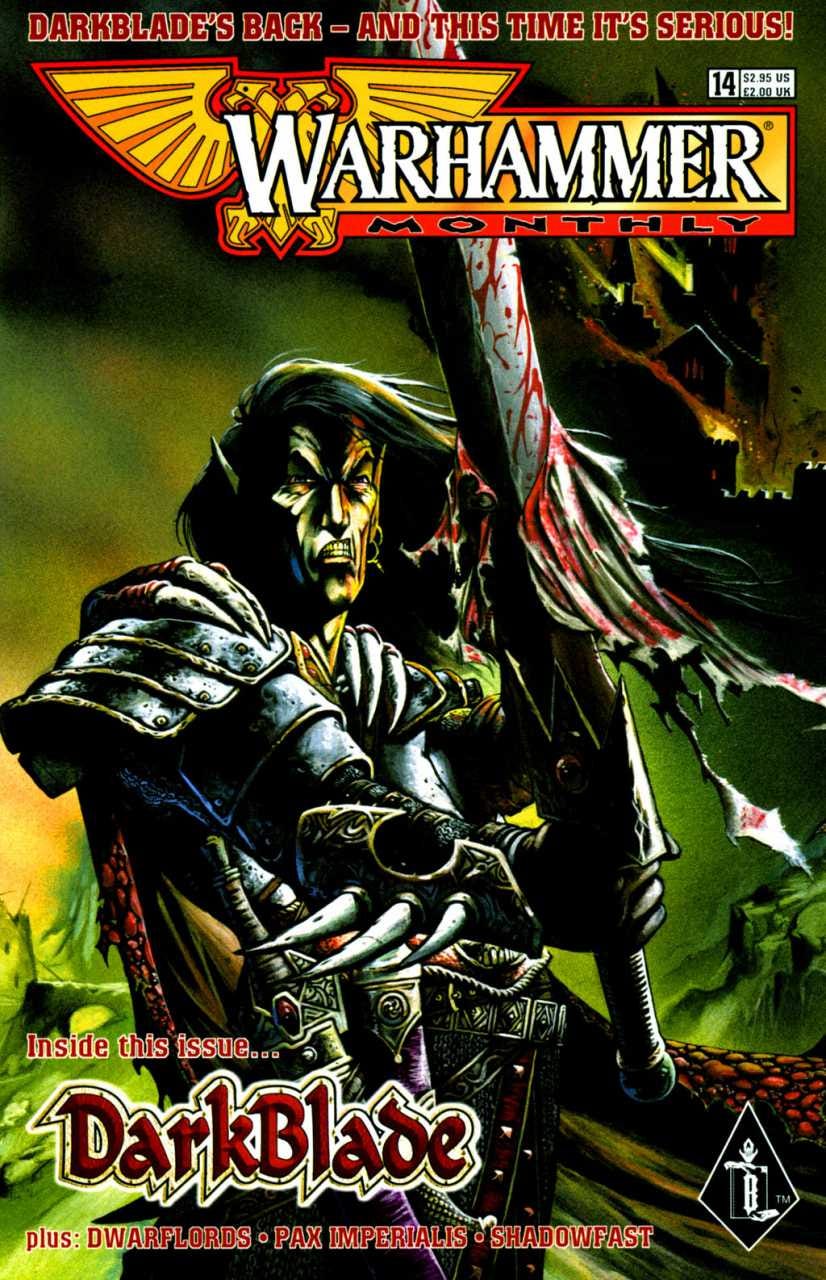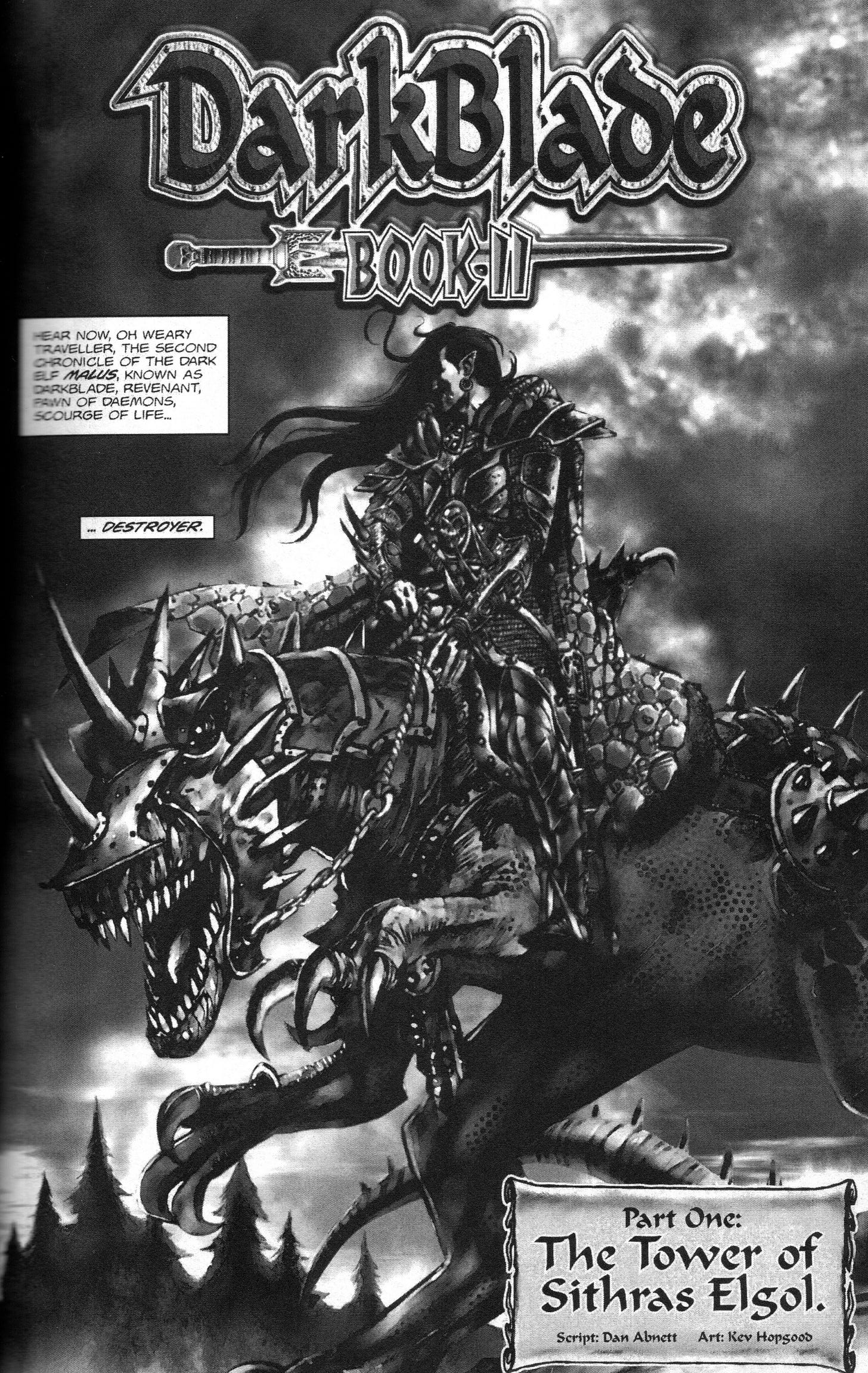Darkblade Book Two: World of Blood - A Warhammer Comic Review
The second comic book outing for the lonely king of Warhammer Fantasy comics, Malus Darkblade. It's a fun jaunt that improves on an already strong foundation.
Darkblade Book Two: World of Blood
Published in 1999
The second illustrated outing for Malus Darkblade, Warhammer’s beloved Dark Elf anti-hero, Darkblade Book Two: World of Blood takes place entirely after the events of the better-known novel series. This volume charts Malus’ second quest to retrieve his soul, lost during the violent exorcism of the daemon Tz’arkan. It’s twice as long as the last volume and less focused, but in most respects, it’s a whole lot more fun. Dan Abnett returns as writer, and Kev Hopgood is back on art, providing a strong sense of continuity often absent in Western comics and Warhammer fiction.
More importantly, Malus comes into his own as a flamboyant adventurer who clearly enjoys his treacherous ways but also can’t come up with a solution that doesn’t put himself in harm’s way.
Many of the elements and tropes from the last volume still apply: Malus is on a quest to save his putrid, dark soul and must gather dubious chaos artifacts while contending with their strange guardians. One major change is the absence of Tz’arkan and their bickering back and forth. Once again traversing Chaos-tainted wilderness, he’s often left talking to himself, inanimate magic artifacts, or his gormless dinosaur-like mount, Spite.
Malus feels like a changed character without the daemon possessing him. While the traumatic experience didn’t lead the Dark Elf to reconsider his ways, it did make him even more reckless.
So, while I found myself missing the Tz’arkan/Malus dynamic, the lack of moderating influences also gives Malus more room to be a diva. Like the first volume, he’s not a complex character, and these stories are very much spectacle-driven, sword-and-sorcery pulp adventures. But Abnett gives us a “hero” who’s completely, unrepentantly self-interested, an element from Book One that’s even more prominent this time around. No trick is too dirty, no slight too small, and no situation hopeless enough to make him accept defeat.
Some of the twists are repetitive, as despite his desperation to regain his soul, Malus is happy to use the unique situation against his sorcerous foes. But even more monstrous opponents getting caught off guard by his underhanded ways remains charming, especially since he’ll always take the chance to rub it in. The quality of one-liners has improved; the dialogue remains delightfully hammy and largely played straight.
Frankly, I find Malus’ lack of nuance refreshing. As modern Warhammer struggles with depicting authoritarian supersoldiers whose heroics feel less and less ironic, here you get a character who comes from a vicious empire of slavers and acts like it. There’s no secret justifications, tragic element, or even human moments from Malus – he’s a bastard that his opponents find distasteful. Later Warhammer books, like the Swords of the Emperor duology, feature morally bankrupt characters that the story struggles to rationalize or give more humane qualities. Malus skips that game altogether and feels less ethically fraught.
Just as crucially, Abnett isn’t afraid to have Malus humiliated, often as a result of his rash actions. Black Library books like Trollslayer flirt with that idea, but using protagonists that are ultimately sympathetic. Here, you’re looking forward to seeing how Malus gets knocked down a peg. One of the consistent highlights is when his opponents turn out to be just as desperate, petty, and treacherous, to our protagonist’s surprise and dismay. And World of Blood continues the last volume’s trend of giving him hard-fought but ultimately bitter, monkey’s paw-style victories.
While most of the story is driven by comic book action and Malus’ biting wit, we’re treated to early Black Library’s less uniform, less game-driven vision of the Warhammer World. Malus finds himself in strange and unique locales, which fit into Warhammer Fantasy’s rigid cosmology in new ways - or not at all. Malus’ quest eventually brings him into contact with the Screaming God Child, a powerful daemon only loosely explained. There’s a suggestion that he’s more than a daemon prince, fearfully imprisoned by the four Chaos Gods at the dawn of time. It’s a major element to throw into the mix and one mostly left to the imagination, but that’s the sort of thing game settings like Warhammer Fantasy benefit from. These mysteries make the Old World feel properly… old.
Though he has a relatively brief appearance, the God Child is a good match for Malus, another outcast lord drunk on the power he once had–but the would-be deity proves even more immature and petty. His inspirations are pretty transparent, another Warhammer Monthly borrowing from British comic giant 2000 AD - the Screaming God Child visually and conceptually resembles the Judge Child from Judge Dredd, another deity-like being turned capricious monster. Notably, both Abnett and Hopgood had plenty of work featured in the “Galaxy’s Greatest Comic” before their outings in the worlds of Warhammer. Regardless of his origins, the God-Child makes for a good climax and helps Warhammer Fantasy feel a little less uniform and a little more strange.
For the visuals, Kev Hopgood brings a tighter art style that mostly eschews the awkward CG and early Photoshop effects that plagued the first book. He still adheres to the tabletop designs but gets more chances to drift from them. The longer page count gives his action sequences more room to breathe to unfold, and he puts the additional space to good use. His framing and layouts also improve significantly, with some of my favorite tableaus from Warhammer comicdom coming from World of Blood. True to his ego, Malus gets plenty of strutting and posing in, but there’s a sense of kinetics and scale integral to the Warhammer identity.
On that note, Hopgood’s art also plays a big part in making Malus feel more realized, playing up his bombastic facial expressions and personality. Hopgood makes him look appropriately cool, wild, and ridiculous when and where it’s appropriate. Like the Dark Elf himself, the art has a much stronger voice this time around.
While not quite as tight as Born of Blood in some ways, World of Blood pulls ahead in most other areas, particularly in terms of the visuals and making the most of Malus’ villainy. Once again, we get a conclusion that nicely wraps up this particular quest while setting up the next. And fortunately, it leaves you wanting more.
The Darkblade comics were never released digitally. Darkblade Volume Two: Born of Blood can be found for around 20 USD, with the more comprehensive collected editions occasionally showing up at that price but usually costing more.










